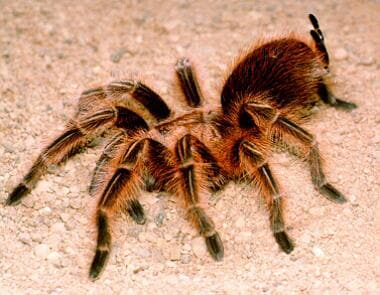Background
Tarantulas are among the largest spiders in the world and likely the most feared. Emergency physicians are increasingly likely to encounter patients who have had tarantula contact as the popularity of tarantulas as pets is increasing.
Tarantulas belong to the suborder Orthognatha and the family Theraphosidae. These large (2.5-7.5 cm) arachnids are slow moving. Females can live as long as 35 years, while the male life span is generally 5-7 years. They have poor eyesight and sense their prey through vibrations. The largest species, Theraphosa blondi, which is found in South America, can have fangs 1 inch long and a leg span up to 12 inches.
Tarantulas generally can be found in tropical and subtropical areas of the world. [1] The largest tarantulas are found in South America. In the United States, great numbers are found in the southwestern states. Most tarantulas sold in pet stores in the United States are imported species of Aphonopelma.
Although tarantulas often evoke panic and anxiety on sight, these hairy long-legged spiders generally are nonaggressive and rarely bite. Tarantulas usually retreat as their main line of defense.
If forced to defend itself, the arachnid may flick very fine, fiberglasslike, sharp, barbed hairs from its abdomen at its enemy (shown in the images below). These may stimulate ocular, dermatologic, and respiratory tract irritation. Density of hairs on the abdomen is approximately 10,000 per mm2.
See Venomous Spider Bites: Keys to Diagnosis and Treatment, a Critical Images slideshow, for help identifying and treating various envenomations.
A tarantula may bite, but first assumes a strike position by raising its front pair of legs and rearing back on its abdomen.
Of historical interest is a piece of 14th-century folklore that arose from the Lycosa tarentula (actually a wolf spider) of southern Italy. Certain individuals who thought they had been bitten by this spider would attempt to exhaust themselves by dancing wildly. This condition came to be referred to as tarantism. It has been suggested that the arachnids responsible for these episodes were actually widow spiders of the genus Latrodectus. [2]
Also from the Middle Ages are reports of a dancing mania known as Tanzwuth that was attributed to spider bites. [3] So-called victims would seek out minstrels who would play instruments with shrill tones; this music caused the victims to dance until they fainted. Seizures, demonic possession, and tarantula bites all have been proposed as causes of this behavior. However, no true etiology has been identified, and dancing mania still remains a mystery.
Pathophysiology
Because of the tarantula's forms of defense, human injury is limited mainly to skin and ocular involvement, with occasional respiratory symptoms.
Tarantula venom is rarely toxic to humans; bites from tarantula species in the United States can be painful but are not considered dangerous. [4] The typical effects are no more serious than those of Hymenoptera stings. [5] The most common reaction is a low-grade histamine response. [6]
Envenomations from the funnel web spider of southern and eastern Australia can be dangerous, even fatal (see Funnel Web Spider Envenomation).
Hairs discharged from the tarantula can penetrate several layers of skin or ocular tissue and cause mechanical irritation. Urticating hair morphology ranges from type I to type IV. Only type I hairs are found in US tarantulas, and these do not penetrate the skin as deeply as other types. Type III hairs can penetrate up to 2 mm, causing inflammation and local reaction. Although not common, inhalation of urticating hairs may cause significant allergic rhinitis. Exposure to hairs of certain species in South America (Grammastola) can suffocate small mammals within 2 hours.
Epidemiology
Frequency
United States
Approximately 40 species of tarantula live in the United States. The incidence of tarantula-inflicted injuries is not known.
International
More than 1500 species of tarantula live throughout the world. Outside the United States, tarantulas can be found in Mexico, Central America, South America, the Caribbean Islands, Africa, areas of Europe bordering the Mediterranean Sea, and Australia.
Prognosis
While all North American species are relatively harmless, a few species in South America, Africa, and Australia may be dangerous to humans (see Funnel Web Spider Envenomation).
Experience with ocular injuries is somewhat limited, and more information is necessary for accurate conclusions regarding long-term prognosis.
Recovery from eye injuries may be prompt but has been delayed up to 72 months.
No cases of infection from tarantula bites or skin exposure to urticarial hairs have been reported; therefore, prophylactic antibiotics are not recommended.
Patient Education
As tarantulas become increasingly popular as pets, owners need to be aware of the potential injuries that can occur.
Discourage frequent and routine handling of tarantulas. Handlers should wear gloves, avoid tarantula contact with their face and eyes, and wash their hands after working with tarantulas.
For patient education resources, see the First Aid and Emergencies Center as well as the patient education articles, Black Widow Spider Bite and Brown Recluse Spider Bite.
-
The Chilean rose tarantula. The urticating hairs are clearly visible. Courtesy of Mike Dembinsky.
-
Enlargement of tarantula hairs. Courtesy of Cara Shillington.
-
Slit-lamp photograph showing 2 central infiltrates caused by urticating tarantula hairs (arrows). Courtesy of Southern Medical Journal and David A. Belyea, MD.











